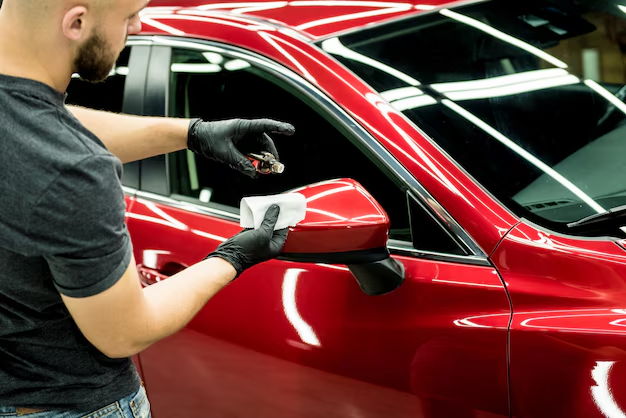Window tinting has evolved from a style factor to a critical component in automotive, residential, and commercial buildings. This change is fueled by the desire for privacy, safety, UV protection, and improved energy efficiency. Among the various tint options available, ceramic and regular tints are the most debated. Understanding their differences is crucial in making an informed decision. This article delves into the details of ceramic versus regular tint, backed by reliable data and sources.
Understanding Window Tint: An Overview
The concept of window tinting transcends aesthetics by offering practical benefits like reduced glare, UV protection, and interior comfort. Tint films are usually classified based on the materials they are composed of; with ceramic and regular tints being among the most popular options used for different purposes. The choice between these tints depends significantly on individual needs and environmental factors.
What is Ceramic Tint?
Ceramic tints are made using advanced nanotechnology that involves embedding ceramic-based particles into thin films. Unlike metalized or dyed films, ceramic particles help in blocking UV rays and solar heat without interfering with radio signals or cellular reception. Key advantages include:
- Excellent UV Protection: Blocks up to 99% of harmful UV rays.
- Enhanced Solar Heat Rejection: Effective in reducing a significant amount of solar heat.
- No Signal Interference: Non-metallic construction allows for optimal signal transmission.
- Durability: High resistance to fading, cracking, and bubbling over time.
Ceramic tint films are designed for longevity and enhanced performance, making them a popular choice for those seeking premium protection and comfort.
Understanding Regular Tint
Regular tints, generally known as dyed films, are considered more budget-friendly and provide various shading levels. These films involve a layer of dye to absorb solar heat and reduce glare. Key characteristics include:
- Cost-Effective: Typically less expensive than ceramic films.
- Variety of Shades: Available in many shades to suit aesthetic preferences.
- Moderate Heat Rejection: Effective but not as high-performing in reflecting heat compared to ceramic tints.
Regular tints are suitable for individuals looking for an economical option to enhance privacy and add style to their windows.
Performance Comparison: Ceramic vs Regular Tint
The real differentiator between ceramic and regular tints is their performance capabilities. The following table offers a comparative look at these key performance metrics:
| Feature | Ceramic Tint | Regular Tint |
|---|---|---|
| UV Protection | Up to 99% | Up to 90% |
| Glare Reduction | Extreme | Moderate |
| Heat Rejection | High | Moderate |
| Signal Interference | None | Possible |
| Durability | High | Medium |
| Cost | Higher | Lower |
From the table, it is evident that ceramic tint offers superior performance in terms of heat rejection, UV protection, and durability, albeit at a higher cost.
Availability and Market Trends
The window tint industry has experienced significant growth in recent years. According to a report by Grand View Research, the window film market size was valued at USD 9.89 billion in 2020 and is expected to grow at a compound annual growth rate (CAGR) of 5.1% from 2021 to 2028, driven mainly by increasing awareness about energy conservation and eco-friendly window films. Ceramic films continue to gain popularity as consumers become more informed and prioritize long-term benefits over initial costs.
The Environmental Impact of Window Tints
A crucial aspect of window tinting is its environmental implications. Tints contribute to energy efficiency by reducing cooling and heating costs, thus lowering carbon footprints. Ceramic tints, in particular, stand out due to their higher efficacy in temperature regulation without chemical emissions. This makes them a sustainable choice in both residential and commercial applications.
Legal Considerations for Window Tints
Regulations around window tints vary by jurisdiction, crucially impacting the allowable tint level and type. In the United States, federal standards mandate vehicle window tinting limits to ensure that proper visibility is maintained for safety purposes. Home and business tints also need to observe local building codes. Prospective consumers should consult local regulations to ensure compliance before proceeding.
Installation and Maintenance
Both ceramic and regular tints require careful installation to prevent issues such as bubbling or peeling. It’s recommended to employ professional services, such as those provided by Alarms and Tint KC. Regular maintenance involves cleaning the tint film with non-ammonia-based cleaners to ensure longevity.
Consumer Insights and Considerations
When choosing between ceramic and regular tints, consumers should weigh their needs concerning budget constraints, environmental conditions, and desired performance. While ceramic tints provide superior performance, regular tints fulfill basic requirements more cost-effectively.
Key Takeaways
In summary, the choice between ceramic and regular tint depends on weighing performance benefits against cost considerations. Ceramic tints stand out for their superior UV protection, heat rejection, and durability, suitable for consumers looking for premium quality. Regular tints offer an economical alternative, suitable for budget-conscious consumers seeking privacy and aesthetics. For expert advice and installation, consider contacting Alarms and Tint KC.
FAQs About Ceramic vs Regular Tint
Are ceramic tints worth the extra cost?
Yes, for many consumers, ceramic tints prove worth the additional investment due to their superior performance. They offer up to 99% UV protection and high solar heat rejection, leading to better thermal comfort and interior preservation. Over time, the energy savings from reduced air conditioning loads can help offset the initial cost premium of ceramic films. Additionally, their nanotechnology construction ensures longevity, making them cost-effective in the long run.
Can regular tint effectively protect against UV rays?
While regular tints offer some UV protection, they generally don’t match the high level provided by ceramic tints. Standard dyed films block up to 90% of UV rays, enough to protect skin to some extent and minimize interior fading. However, for comprehensive protection, particularly in high-sunlight regions, ceramic tints are recommended as they can block up to 99% of these harmful rays.
How does window tint affect vehicle and home heating and cooling costs?
Window tints, particularly ceramic films, significantly affect heating and cooling costs by reflecting solar rays, thereby reducing indoor temperature. This efficiency means air conditioners and heaters do not work as hard to maintain comfortable interior temperatures, potentially leading to substantial energy savings. According to the International Window Film Association, professionally installed window film can reduce cooling costs by up to 30%.
Will window tinting interfere with GPS or mobile signals?
Metalized tints are known for their signal interference issues due to the metallic micro-layers. However, both ceramic and regular dyed tints do not suffer from this problem. Ceramic tints, in particular, are constructed to ensure there is no interference with radio signals, GPS, or cellular reception, making them an excellent choice for vehicles or homes where seamless connectivity is essential.
What should I consider when selecting a window tint for my car or home?
The key considerations include performance needs, cost, aesthetic preferences, and local legal regulations. Determine what aspects, such as UV protection, heat rejection, or privacy, are most critical. Assess budget constraints as ceramic films are typically more expensive than regular ones. Ensure compliance with regional laws on permissible tint levels. Engaging an experienced installer like Alarms and Tint KC can provide expert guidance tailored to personal and situational needs.
For more information on selecting the right tint for your needs, visit our contact page to get in touch with us.

